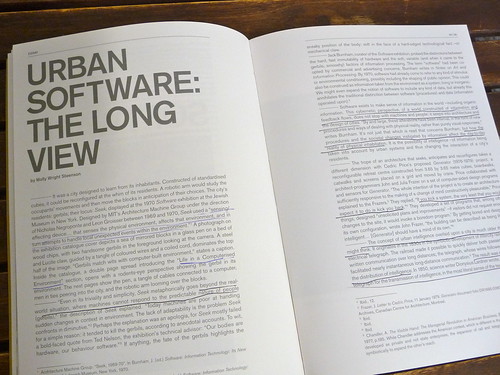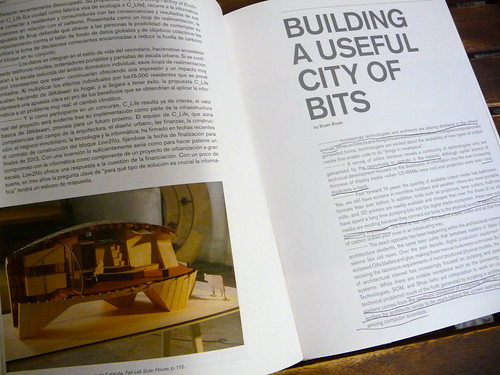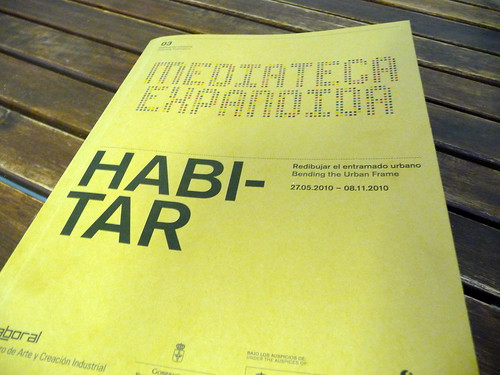The HABITAR Essays
Posted: July 16th, 2010 | 3 Comments »For the HABITAR exhibition, we wanted to augment the catalogue of design scenarios with essays that challenge and explain the new practices, tools, solutions and languages that are being developed to negotiate the near future of cities. With an objective of transdisciplinarity with the language of architects as a backbone, each contribution meant to participate to a common dialogue with a unique perspective. I believe it worked quite well, so I strongly encourage you to read them downloading (pdf) or purchasing (5.00€) the catalogue.
Here is brief – overly summarized – overview of the essays and their articulations as part of the script José Luis de Vicente and I had planned.
“Urban Software: The Long View” by Molly Wright Steenson
First, we wanted an historical account of the concept of urban intelligence that resonate in many of the contemporary discourses. Right at that time Molly Wright Steenson had contributed to the Microsoft Social Computing Symposium with an “introduction of computing to urbanism and urban planning”. Molly kindly agreed to synopsize her talk and investigation in that domaine. In “Urban Software: The Long View”, she describes the emergence of active forms of intelligence from the distribution of information and commands for interaction (starting with the development of intercity railroad and electrical telegraph) and new procedures (software with the information and feedback flows they generate):
The concept of urban intelligence overlaid upon a city is much older than one might think. It originates in the 1830s in the symbiotic development of intercity railroad and electrical telegraph. The railroad made it possible to quickly deliver both passengers and written communication over long distances; the telegraph, whose wires followed rail lines, facilitated nearly instantaneous long-distance communication. The result was no less than the distribution of intelligence. In 1850, science writer Dionysius Lardner wrote, “The Electric Telegraph for the transmission of intelligence, in the most literal sense of the term, annihilates both space and time.” The telegraph, in Lardner’s view, rendered moot concepts of geography, distance, duration, and tempo. It altered all of the possibilities for connectivity and shifted society’s expectation for information. The diffusion of knowledge over space and time—the “transmission of intelligence” to which he refers—would cause “the increase of civilisation by intellectual means.” The new mobility provided by communication was tantamount to the growth of intelligent society. Telegraphy, in his view, was a system for distributing culture.”
This perspective of a world constructed of information and feedback flows naturally seeped into architecture and the design of cities, leaving computer scientists and architects wondering about “Life in a Computerised Environment”, with concerns on the the particular lack of adaptability of computerized systems that are poor at handling sudden changes in context in environments and concerns in ways of dealing with physical reality:
Software exists to make sense of information in the world—including organic information. This cybernetic perspective, of a world constructed of information and feedback flows, does not stop with machines and people: it seeps into architecture and the design of cities. “By and large, these alterations have been internal, in the form of new procedures and ways of dealing with physical reality, rather than purely visual responses,” writes Burnham. It’s not just that which is read that concerns Burnham, but how the procedures and the societal changes instigated by information affect the day-to-day reality of physical inhabitation. It is the possibility of intelligence—of information being taken into account by urban systems and thus changing the interaction of a city’s residents.
Some of the the intelligent systems exhibited at HABITAR annihilate conventions produce a radical shift in the notions of time and space, leaving Molly wondering on the combination of people behaviors and cities mediated by software:
Intelligent systems, in short, annihilate convention. They introduce a radical shift, whether in time and space, as with the telegraph, or in procedures and information—software and data—that Burnham described. If we magnify Ted Nelson’s statement, “Our bodies are hardware, our behavior software,” how do our bodies meld with our cities, mediated by software? And just what might our cities learn from us?
“Building a Useful City of Bits” by Bryan Boyer
The building of cities and the bringing of technology to life should have led to a natural convergence in the architects/designers and technologists practices. However, to the exception of some pioneer works the cross-disciplinary combination of deep expertise in technology and spatial design remains highly uncommon. Being an active actor in both worlds, Bryan Boyer has been vocal about the antagonism of practices. We invited him the explain the promises of cross-disciplinary work to help “Building a Useful City of Bits”.
Even with large body of work in the community of technologists to dissolve information with a vast quantity of output media and the banality of digital production equipment in architecture schools and ateliers, we are still left wondering “What urban informatics is actually instrumental in solving?”
Efforts to combine these two fields have yielded modest results: technology happens to exist in the city, such as the digital screens now dotting many central business districts, and buildings happen to have some technology glued on to them, here and there an LCD facade. The more that practitioners on both sides of this divide actively engage, understand, and recombine each others’ working modalities—rather than just the output formats—the better the outcome will be. The attention-grabbing aspect of cross-disciplinary collaboration may be its outward expression or formatting, but the transformative potential is in finding hybrid working models.
Cross-disciplinary works becomes key to finally demonstrate that urban informatics is a worthwhile endeavor at an urban scale. Bryan has been active in setting up projects involving the expertise in technology, architecture, interaction, space and finance:
The C_Life team, bringing together expertise from the fields of architecture, urban design, finance, construction, real estate, technology, and informatics, recently signed a contract to build the Low2No block, which has a projected completion date in late 2013. With a serious investment demonstrating a mission-driven commitment to support informatics as part of a large scale development project, Low2No is one answer to the question of financing. With a little luck, in three years time the key question of, “What are informatics instrumental in solving,” will have a sketch of an answer.
“Notes on the Design of Participatory Systems – For the City or For the Planet” by Usman Haque
Other practitioners at the frontier of architecture/design and technologies have explored other forms of cooperation with the involvement of the many actors of the city. Usman Haque has been active in building participatory systems (see his Lift France talk on Chaning Things). He agreed on illustrating the paradoxical structures of collaboration and the ways that the paradoxes can be harnessed. He particularly highlighted 10 key elements in the design of participatory systems (here overly summarized):
- Dilemmas: you cannot rely on the end goal being incentive enough to encourage individuals to participate and cooperate on achieving the end goal.
- Incentives: a participatory system needs to have intermediary, short term incentives from which participants can gain tangible benefits
- Increments: incremental participation results in incremental gains; they cannot depend on an “all or nothing” situation.
- Trust and evidence: trust largely comes from evidence; and self-constructed evidence is the best of all because it does not require second-hand knowledge.
- Tools for evidence: determining indicators for success is crucial
- Opting out: the choice of “opt out” must not be made into a value judgement by thos who “opt in”.
- Granularity: in any participatory system there will be those with different skillsets, different responsibilities, different desires, different commitment levels and different time-availability.
- Coupling: rather than trying to develop solutions to individual problems, construct means for incremental incentivised actions in two seemingly unrelated domains to benefit each other.
- Complexity: it it’s that complex, it means it’s beyond professional capabilities of any single individual: it *demands* cooperation. […] a designer is there to ensure that that goal is *not fixed* but can be overridden by participants.
- Public spectacle: if a public spectacle is engaging, it encourages people to observer, ask questions, occasionally even participate.
“The Gifted City: A Design Concept” by Anne Galloway
Technologist, architects and designers envision special or even superior kind of cities, gifted in their abilities. But also gifted because they are being given as gifts. It is this theme of the gifted city that Anne Galloway presented last year at Lift in Geneva. Unfortunately, there is no video archive of her talk, so we thought that HABITAR provided an extra opportunity to capture her thoughts on the relations between the designers and consumers/users of sentient and reactive environments.
The gifted city instantaneously connects us to others near and far, places us where we need or want to be, maps our activities in real-time and captures information for our later action. The gifted city promises that we can become gifted individuals.
These new products and services can also be seen as gifted objects or abilities, in the sense that they have been given as gifts.
The ideal gift does not establish a relation of obligation but instead, as it happens in our everyday lift, opens up imminent relations between subjects, expanding these relations to other forms of exchange and becoming. But there are also gifts the we do not want, need or understand, of course raising complex implications in the design of gifted cities with its services and objects:
The gifted city I have conjured is an extraordinary city given to us by well-intentioned designers. But my conceit raises more questions than it provides answers and I wonder what kind of gifts and gift-relations we are creating. What happens to the cities and people that do not receive our gifts? Are our gift-relations free from obligation, or do we expect something in return? Do we design with ourselves in mind, or others? Do we design for abstract users and scenarios, or for concrete people, situations and affects? Do we give gifts that expand possibilities and open up space for new relations, or do we reinforce existing affiliations? Can our gifts only be used in particular ways, or can people use them as they wish?
We know that gifts and gift-giving involve complex, and sometimes even fraught, values and activities. But they also involve fundamentally caring relations, and with each gift we create we too are given something: the opportunity to create a richer, more meaningful gift. So what kind of city would you like to give and what kind of city would you like to receive?
“Snapshots From a Fictional Asynchronous City” by Nicolas Nova
Nicolas Nova further questions the content of these gifted cities and their emphasis on instantaneity and real-time as a limiting metaphor, a thought he started to frame in the pamphlet A synchronicity: Design Fictions for Asynchronous Urban Computing he wrote in company of Julian Bleecker. In “Snapshots From a Fictional Asynchronous City”, further exemplifies his critique of the obsession on the present and the ephemeral:
Moreover, the focus on instantaneity in this Urban Informatics projects often leads to a relative absence of consideration towards other temporal dimensions. Designing meaningful and original new media experiences may considerably benefit from a more complex understanding of time.
From his critique, he describes project that go beyond the conventional assumptions about digital experience of space. For instance the Slow Messenger, developed at the Near Future Laboratory in company of Julian Bleecker, that provokes on the spirit of a affinity from pre-digital correspondence. Similarly, Jotyou is a communication system that enable people to send message in a potential future without knowing when a message can be read, only where. These projects show the opportunities in pushing the envelope of the “real-time meme”.
What these various projects show is simply that there are intriguing ways to go beyond the “real-time meme” that pervades current instantiations in Urban Informatics. In order to create such orthogonal perspectives, one should consider how to foster new modes of experience and occupancy of space. In that spirit, it can be pertinent to create connections between unexpected events and rethink the intricate relationship between time and space. Rather than taking people as the receptacle of instantaneous solicitation from mobile devices and interactive architectures, there might be ways of engaging them into new forms of encounters or exploration In other words, what are the opportunities for re-imagining the databased city that have not been directly designed-into these systems?
Sure, the explorations mentioned here may seem weird and futile at first glance. But down the road, one should see them as props to contemplate issues bigger than the objects themselves, and to help us imagine near future worlds that wait to be uncovered.
“Flowing, Dwelling, Thinking” by José Pérez de Lama
Finally, we wanted to terminate the set of essays taking some more altitude linking ubiquitous networks with architectural theoreticians. José Pérez de Lama kindly played the theorist role inspiring from Martin Heidegger’s classic 1951 text Building, Dwelling, Thinking which introduced the concept of “dwelling” into the real of architectural debate (“the objective of building is to dwell”). Heidegger assumes that there is an unavoidable connection between dwelling and staying, to which José suggest to augment with “flowing”:
But today we know that our being on the earth is just as linked to remaining as it is to what we could call “flowing”, borrowing in part from Manuel Castells. There is a whole new spectrum of dwelling, fundamental to our experience of being in the world, that is linked to movement, communication, the new dynamic image and information ecologies.
[...]
It is certainly true that in 2010, ubiquitous networks, proliferating information and the growing numbers of artifacts that extend our physical and mental capacities, mean that this new way of dwelling that we could refer to as “flowing”, “floating”, or both, has become a defining and distinguishing condition of our being in the world today.
And José requesting to critically consider these new forms of dwelling governed by ubiquitous computing and hyper-connectivity.
Tow what extent do they contribute in stimulating production and generating an egalitarian redistribution of the wealth of networks? To what point do they favor a social organization of a critical nature?
Why do I blog this: We wanted these essays contribute to the dialogue between the practices in technology, interaction and spatial design that are timidly converging. They highlight some of the reasons why the discourses on urban informatics are not fully convincing (yet), acting as a balance with the many proposals presented at the exhibition. Finally it was an opportunity to gather voices and thoughts contribute to the large – but not exhaustive – body of works (publications, exhibitions, urban demos/probes, …) produced by Adam Greenfield, Dan Hill, Stephen Graham, Marcus Foth, Kazys Varnelis, Mark Shepard, Carlo Ratti, and many others inspiring theorists and practitioners. I admit thought I would have loved to add voices from Asia and Africa.





Lovely write-up, and congratulations on having assembled an impressive body of thought.
I think you may mean “Mark Shepard,” though. : . )
Thanks Adam. Of course I meant Mark Shepard :s
Great STUFF! Will keep digging into it. Since you mention it, here’s one, tiny voice from one tiny space in India: http://superflux.in/blog/?p=1165